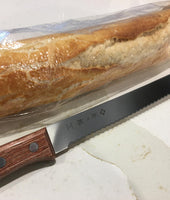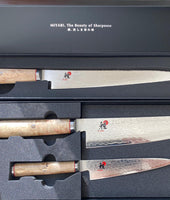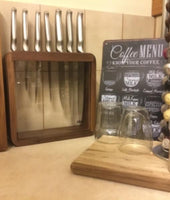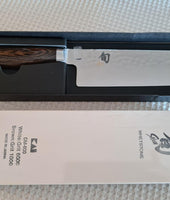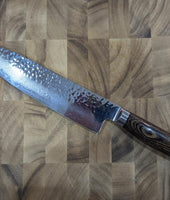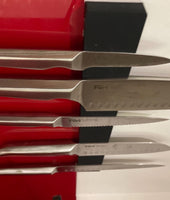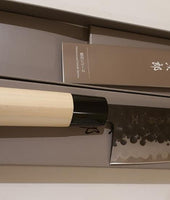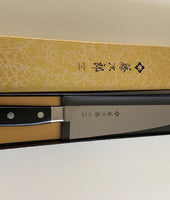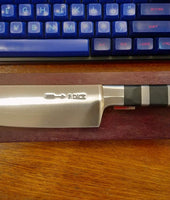Do you want to know how to buy the best Japanese kitchen knives? You have come to the right place. After reading this post, you will be able tell the difference between many Japanese knives and make the best buying decision.
What is a Japanese Knife?
The reputation of the knives of Japan originates from the country's ancestral times and the Samurai warriors. Their blades were among the sharpest in the world. After the 19th century, many forgers of the time resorted to making kitchen knives. If you encounter a Japanese knife, three elements should stand out.
- The unique shape of its blade, which defines its use (s)
- The steady and splendid design of its blade, which will indicate its hardness and, therefore, its sharpness
- The shape and composition of the handle
What form of blade should I choose?
There are Japanese knives with two edges, but there are also knives with only one edge. Therefore, you will have to be very careful when choosing your knife to what you buy and deliver as you expect.
Asymmetrical knives are the most versatile. You can choose a left-handed or a right-handed knife. There are also ambidextrous types available. Single-edged blades are used to cut fish or meat very finely. They also make it possible not to denature the ingredients, thanks to this one-sided slicing.
These blades are also used for:
- Cut off fish heads
- Remove skin from fish
- Lift the fish fillets
Compared to the symmetrical V-shaped blade, which presses on the two parts of the item, the asymmetrical blade (or chisel) separates the parts with a clean-cut, leading to fewer chances of food wastage.
And just so you know, in Japanese culture, the quality of the cut shows the respect you give to the guests. Therefore, there are knives for each kind of task to preserve the taste and quality of the ingredients and to show great respect to guests.
Types of Japanese Knives
1. Japanese boning knife
Choosing a good boning knife is no easy task. It is essential to choose a strong enough blade designed to easily de-bone your meats, as is the case for the Tojiro DP3 Series Boning Knife 15cm.

As we have seen on numerous occasions, the blades of Japanese boning knives have a cutting power far superior to their Western cousins. Part of this superiority is due both to the fineness of the Japanese blades. The hardness of the steel used in the manufacture of these knives is also reputable.
When choosing a Japanese boning knife, size is also important. A smaller 5- 6-inch knife may offer you greater flexibility, but a 7- 8 inch knife may serve you better when de-boning a large animal.
You also have to look at the blade shape. You have two options, curved or straight. Choose curved knives for trimming and precision work and straight blades for achieving larger cuts.
Curved blades make cleaner strokes through the meat. These blades are also easier to use when filleting smaller animals such as qual. Straight blades are for sculpting and delicate slicing. But as long as your blade is sharp, don't restrict yourself to rules.
2. Japanese peeling knife
The Miyabi Birchwood 5000MCD Paring Knife 9cm can be used to peel your fruits and vegetables because it is versatile. Its blade is V-shaped, and it delivers fast and precise cuts.

Experts hold that size should be the first thing to look at when choosing a Japanese peeling knife. These knives are designed for use on delicate cutting and peeling work, and so they should be small for agility and comfort.
Like the Miyabi Birchwood 5000MCD Paring Knife 9cm, the best Japanese peeling knife is about 2-3 inches long. Choose the length based on the versatility you need and your practical expertise with kitchen knives. We suggest that if you have smaller hands, choose smaller peeling knives so you can work much more comfortably.
Paring knives come in various materials, from ceramics to stainless steel. Miyabi Birchwood 5000MCD features a CRYODUR blade with MicroCarbide MC63 powdered steel. Such steel blades are a dozen times stronger than ceramic knives.
Further, it pays to choose peeling knives with stronger blades for better sharpness and an improved ability to withstand wear and tear. You might also want to consider handling strength and aesthetics.
3. Japanese Santoku knife
The Santoku is the ultimate versatile knife. If you can only have one Japanese knife, choose this one. It is better to pay the price for just one good utility knife than many you may never need.
This type of Japanese knife will mincemeat, fillet fish, or slice vegetables as well. This is the knife to have in your kitchen! Check out our article to find the perfect Santoku.
When shopping for the Japanese Santoku knife, remember that thin blades are essential to achieve thinner slices. A thin blade will be critical when you want to get extra thin slices of meat or veggies for sandwich toppings.

Like the Tojiro Hammered Santoku Knife 17cm, you must work with a knife that has a sharp cutting edge. If you choose something over 20 degrees, that will be too big of an angle. We recommend you find a blade with a cutting angle of 15 -20 degrees. But if you find a knife that can be honed to less than 15 degrees, you've found the best Santoku.
4. Japanese vegetable knife
The art of slicing fruit and vegetables is a tradition in Japan. There is even an art dedicated to this discipline: Mukimono. Japanese knives are, therefore, perfect for cutting vegetables.
The Nakiri is the best Japanese vegetable blade. It is ambidextrous with a V blade. It's therefore easy to use by nearly everyone and allows you to make precise cuts.

Flexibility should also be top of your mind. The Tojiro DP3 Series Nakiri Vegetable Knife 16.5cm feels responsive and comfortable. It works reliably even in intricate tasks, saving your strength through an exceptionally sharp blade. However, not every Japanese vegetable blade is necessarily flexible.
In Conclusion
Sometimes, chefs need thinner blades for cutting finer slices. Thinner blades may also help you work much faster with the least resistance. You have so many diverse and innovative options for Japanese knives. Buy now to experience all the advantages.
Also Read: Kitchen Knife Safety Dos and Don'ts - Why It's Important
Explore More Products: Tojiro Pro Flexible Service Filleting Knife 19cm | Tojiro Pro Service Filleting Knife 19cm | Tojiro Pro Service Knife Prosciutto Knife 30cm | Tojiro Sharpening Steel 27.5cm


























